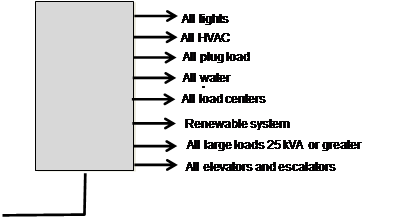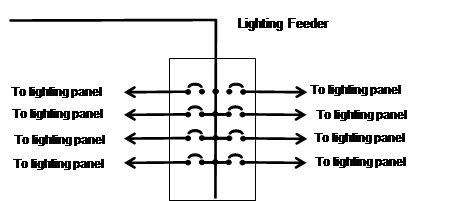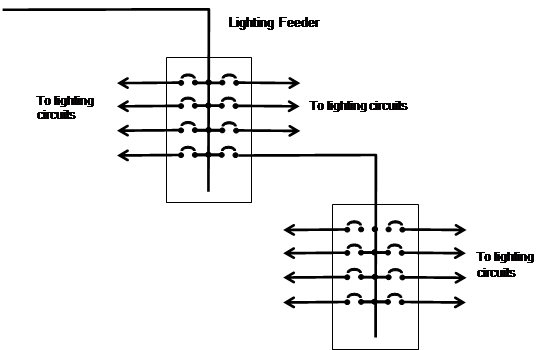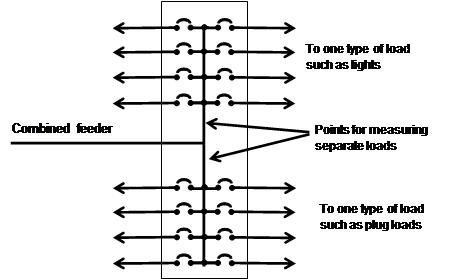8.3
Disaggregation of Electrical Circuits
This section of the Standard requires buildings to be wired
in a manner that separates loads by types onto independent feeders and risers
through the building. This will require separate feeders and panels
for lighting, plug and equipment loads, HVAC loads, etc. The requirements
are contained in Table
130.5-B, reproduced below.
“Disaggregation” means in this case to break down the total
electrical use in the building into groups that permit power and energy use
measurements to be taken, to enable management to determine where energy is
being used. For instance, lighting energy use quantities and patterns can
be studied and excess use or waste can be targeted for improvements.
Note that this requirement does not require any
metering. By placing all load of a particular type on one feeder, a
portable power measurement and analysis device can be temporarily attached to
its feeder, measurements can be made, and then the device can be moved to
another feeder.
In the examples, note that the manner in which disaggregation
occurs does not require specific wiring; for instance, a single feeder can
provide lighting and plug load power as long as the panelboard has a split bus
allowing measurement of one and then the other. However, this can only be
used in a smaller building as the all lighting must be able to be measured at
one point.
This requirement is for new buildings and for major additions
or renovations. It is invoked whenever the service is modified as with a
new switchboard, or when sections are added or new feeders pulled. In an
existing building that is being altered, this requirement is not invoked as long
as the existing service switchboard, existing feeders and existing panelboards
remain essentially “as-is”.
As an alternative to disaggregation, current transformers can
be added to individual branch circuits or loads throughout the building, and a
permanent measurement system can be installed. In this case disaggregated
wiring would not be required as long as the metering system permitted the
equivalent disaggregated measurements. See Exception 1 to Section
130.5(b).
8.3.1
Disaggregation increases as loads get larger
The requirement is progressive. Disaggregation is not
required until the service reaches 50 kVA, which is 60 amps at 277/480 volts
three phase, 150 amps at 120/208 volts, three phase and 200 amps at 120/240
volts single phase. For most small buildings or separately metered
portions of a building, such as a store in a mall, this requirement will not
apply.
Once the service to the building reaches 50 kVA, the
requirements are applied to some groups regardless of actual load, and to other
groups when the group reaches a threshold value of 25 kVA (100 amps at 240 volts
single phase, 70 amps at 120/208 volts three phase, and 30 amps at 277/480 volts
three phase).
For services rated 250 kVA and above, lighting and plug loads
are required to be disaggregated “by floor, type or area”. So in a
single-story building, all the lighting loads could be fed from a single panel,
and all the plug loads could be fed from another panel (or alternatively, both
types of load could be fed from one panel with a split bus).
In a large single-story building it would be useful, but not
mandatory, to split each type of load into sub-panels that serve particular
areas or particular types of light fixture, so these could be metered with the
same CT.
In a multi-story building, a simple way to comply would be to
install a separate lighting panel and a separate plug-load panel for each floor
of the building. However, it would be equally acceptable and more useful
to divide the load according to which area of the building it serves (office,
warehouse, corridors etc.), or by the type of light fixture (metal halide vs.
fluorescent, dimmable vs. fixed output, etc.). So, for instance, both the
first and second floor office lights could be fed from the same panel, while the
warehouse lights would be fed from a second panel. Dividing the load by
area or by type instead of by floor is more likely to yield useful information
when the loads are analyzed in an energy audit. Practical Considerations
These requirements were developed with a reasonably practical
eye. In a small building or service, disaggregation is not required at
all. The minimum threshold of 50-kVA service means that almost all
projects less than 5,000 sf will not be required to comply. Slightly
larger projects will be able to comply by using carefully laid-out panelboards.
The standard envisions the use of conventional panelboards, motor control
centers, through wired panels, and other standard wiring methods. It also
envisions a new generation of creative solutions such as split bus panels, with
separate bus and breaker sections for lighting and receptacles/equipment.
Likewise, clever wiring methods will also emerge, such as connecting all HVAC
units to a single feeder from the service, using a combination of through feeds
and taps. In other words, with minor changes in how power is distributed
in a building, the requirement can be met with little or no added cost.
In larger buildings, this mandatory requirement will make
separate risers for lighting, receptacles/equipment, and HVAC necessary.
Single large loads or groups of loads, such as an elevator machine room, chiller
or commercial kitchen, will have a separate feeder and panelboard or motor
control center anyway; in many buildings these requirements are already met at
least in part.
For buildings with a single large service greater than 50
kVA, such as retail malls, offices and apartment buildings that have submetered
distribution to completely demised tenants, the requirements apply as
follows:
•
Common areas of the building must be disaggregated
•
Individual submetered services must be disaggregated if the submetered
service is 50 kVA or greater, with the exception of residential units, in which
disaggregation is not required.
In remodeled or renovated buildings, the total electrical
load is expected to be reduced as Title 24 lighting power requirements, HVAC
requirements, insulation and glazing requirements, etc. will necessarily cause the original
building to use less energy, and to a certain extent a building can be enlarged
without increasing the service or existing feeders and panels. As long as
the only changes to the electrical system involve changes to branch breakers and
branch circuits, this mandatory requirement is not invoked.
Example
8-1
Single panel with service less
than 50 kVA, which is less than 60A@ 277/480v 3ϕ, 135A @ 120/208v 3ϕ, or 200A @ 120/240v 1ϕ

No requirements for disaggregated wiring
Example
8-2
BASIC REQUIREMENTS FOR DISAGGREGATED WIRING
Service panel with service less than 250 kVA, which is less
than 300A@ 277/480v 3ϕ,
690A @ 120/208v 3ϕ, or
1000A @ 120/240v 1ϕ

This would be typical of a small school or office
building (~25,000 to 50,000 sf), small retail or grocery store (~10,000 to
20,000 sf), etc.
Each feeder serves a breaker panel, load center, or load or
load group with its own disconnect and subdistribution.
NOTES
Large loads smaller than 25 kVA can be connected to load
centers or plug load groups
Load centers can be used to aggregate many small equipment
loads such as commercial or industrial equipment, computer server rooms,
commercial kitchens, retail refrigeration, etc.
A single multi-pole breaker can
be used to feed all branch circuit loads of one type, such as all lighting
loads, in smaller buildings.
Example
8-3
Using a distribution panel to subfeed branch circuit
panelboards. Can be used for lighting, HVAC, plug loads, or any other
group of load types.

Example
8-4
Combined lighting panel with
subfeed to other lighting panel(s).
A larger first lighting panel
(e.g. 400 amps) could subfeed three 100-amp panels, or 6 60-amp panels, and
serve local branch circuits, too.
Can be used for lighting, HVAC,
plug loads, or any other group of load types.

Example
8-5
Using a split bus panel to feed two groups of branch
circuits. Can be used for lighting, HVAC, plug loads, or any other group
of load types. Limited to use in smaller projects where only one panel is
needed for each load type.

Table 8-1 - Required Disaggregation of Electrical
Loads
|
TABLE 130.5-B from the Standards |
|
Load Type |
Services rated 50 kVA or less |
Services rated more than 50kVA and less
than 250 kVA |
Services rated more than 250 kVA and less
than 1000kVA |
Services rated more than 1000kVA |
|
Lighting including exit and egress lighting and
exterior lighting |
Not required |
All lighting in aggregate |
All lighting disaggregated by floor, type or
area |
All lighting disaggregated by floor, type or
area |
|
HVAC systems and components including chillers,
fans, heaters, furnaces, package units, cooling towers, and circulation
pumps associated with HVAC |
Not required |
All HVAC in aggregate |
All HVAC in aggregate and each HVAC load rated
at least
50 kVA |
All HVAC in aggregate and each HVAC load rated
at least 50kVA |
|
Domestic and service water system pumps and
related systems and components |
Not required |
All loads in aggregate |
All loads in aggregate |
All loads in aggregate |
|
Plug load including appliances rated less than
25 kVA |
Not required |
All plug load in aggregate
Groups of plug loads exceeding 25 kVA connected
load in an area less than 5000 sf |
All plug load separated by floor, type or
area
Groups of plug loads exceeding 25 kVA connected
load in an area less than 5000 sf |
All plug load separated by floor, type or
area
All groups of plug loads exceeding 25 kVA
connected load in an area less than 5000 sf |
|
Elevators, escalators, moving walks, and transit
systems |
Not required |
All loads in aggregate |
All loads in aggregate |
All loads in aggregate |
|
Other individual non-HVAC loads or appliances
rated 25kVA or greater |
Not required |
All |
Each |
Each |
|
Industrial and commercial load centers 25 kVA or
greater including theatrical lighting installations and commercial
kitchens |
Not required |
All |
Each |
Each |
|
Renewable power source (net or total) |
Each group |
Each group |
Each group |
Each group |
|
Loads associated with renewable power source |
Not required |
All loads in aggregate |
All loads in aggregate |
All loads in aggregate |
|
Charging stations for electric vehicles |
All loads in aggregate |
All loads in aggregate |
All loads in aggregate |
All loads in
aggregate |




